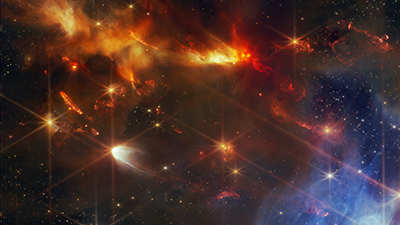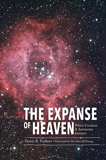
What the James Webb Space Telescope Has Revealed About Distant Galaxies So Far
How should creationists interpret the images from the farthest galaxies yet?
One of the prime objectives of the new James Webb Space Telescope (JWST) is to study very distant galaxies, galaxies that are too far away to be effectively observed prior to the JWST. It isn’t so much that these galaxies are too faint, for there are very large ground-based telescopes that have more light-gathering ability than the JWST. Rather, it is the tremendous redshift that the light of very distant galaxies has undergone. In 1929, Edwin Hubble established that there is a correlation between the distances and redshifts of galaxies. The light of very distant galaxies is shifted far into the infrared. Most infrared radiation is blocked by the earth’s atmosphere, so ground-based infrared telescopes cannot study very distant galaxies. Even the Hubble Space Telescope does not reach very far into the infrared. There have been several high-altitude and orbiting infrared telescopes placed to see beyond the earth’s atmosphere, but with its 6.5-meter mirror, the JWST surpasses them all.
Why Go So Far?
Why do astronomers want to study the most distant galaxies? Most astronomers think the universe began 13.8 billion years ago with the big bang. In this model, stars and galaxies did not exist until nearly a half billion years after the big bang. In that interlude, the universe was an expanding gas—hot at first, but cooling as it expanded. About 370,000 years after the big bang, the temperature of the universe fell to about 3,000 K, cool enough for electrons and protons to form stable hydrogen atoms. The loss of free electrons made the universe transparent for the first time, allowing light to travel unencumbered. The cosmic background radiation (CMB) is supposed to be the greatly redshifted light from this earlier time when the universe was opaque. Perhaps 10 million years later, the universe had cooled and dimmed, leaving it a very dark place. This Cosmic Dark Age persisted for a few hundred million years before the first stars formed and reilluminated the universe. Shortly thereafter, the first galaxies formed.
Expectations and Reality
Astronomers do not understand how galaxy formation took place. A few decades ago, astronomers generally thought gas in the early universe formed into structures that we now recognize as galaxies, in which stars formed. But now most astronomers think that stars formed first and then began to collect into galaxies, followed by additional star formation. Dark matter is now thought to have played a major role in galaxy formation. The JWST ought to have the capability of imaging the most distant galaxies, giving insight into what most astronomers think are the first galaxies in the formation process. Consequently, astronomers are anxious to see the first images of these very distant galaxies. What have they seen so far?
A news story reported on a preliminary study that identified 44 previously unknown galaxies.1 Their redshifts and consequent distances are not yet known, but it is estimated within the big bang model that some of these galaxies may date to only 300 million years after the big bang. Other preliminary studies have identified what may be even more distant galaxies, which would date even closer to the big bang. A more recent study claimed to identify a galaxy so far away that it dates to only 200 million years after the big bang.2 If astronomers accept these distances and ages, then it will require extensive rewriting of their understanding of galaxy formation and early evolution, as well as the formation of stars.
Conclusion
We at Answers in Genesis reject the naturalistic assumptions upon which many of these interpretations are based. For instance, we do not believe that God created the universe via a big bang. Consequently, we view these new images differently. The goodness that God saw in his making of astronomical bodies on day four (Genesis 1:18), as well as the “very good” that God pronounced at the conclusion of the creation week (Genesis 1:30), refers to completeness and functioning as intended. From this, we expect that distant galaxies will be very similar to nearby galaxies. Though they are not necessarily identical to nearby galaxies, the evidence thus far indicates that they are still galaxies all the way back. Furthermore, from the goodness of creation, creationists think that God made stars and galaxies at the same time, so there never was a time when one existed without the other.
We at Answers in Genesis reject the naturalistic assumptions upon which many of these interpretations are based.
There is one other interesting fact that gets scant attention. The first JWST news story cited here reported the detection of elements heavier than helium at great distance. According to the big bang model, the universe began with just helium, hydrogen, and a tiny amount of lithium. All other elements supposedly were forged in stars and gradually increased the abundance of the elements heavier than helium. Astronomers call this process chemical enrichment. This process takes time, so astronomers do not expect to find many of the heavier elements at great distance. If they do, then that will require astronomers to rethink their theories about chemical enrichment and how soon stars formed in the universe. Knowing that God created a complete functioning universe, creationists expect that the JWST will reveal heavier elements existing at the greatest distance we can see galaxies. Time will tell us which expectation is correct.
Footnotes
- Alexandra Witze, “Four Revelations from the Webb Telescope About Distant Galaxies,” Nature, July 27, 2022, https://www.nature.com/articles/d41586-022-02056-5.
- Keith Cooper, “James Webb Space Telescope Beats Its Own Record with Potential Most Distant Galaxies,” Space.com, July 28, 2022, https://www.space.com/james-webb-space-telescope-new-most-distant-galaxies.
Recommended Resources

Answers in Genesis is an apologetics ministry, dedicated to helping Christians defend their faith and proclaim the good news of Jesus Christ.
- Customer Service 800.778.3390
- © 2024 Answers in Genesis








